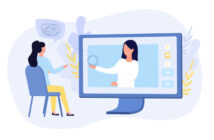BY , MA
When people transition to a new care setting, both they and their care partners (family caregivers) want to do well. But patients worry if they’ll be able to self manage. And family caregivers worry if they will be able to safely provide care and navigate a new care setting. There’s a lot they need to remember, and it’s all a blur. Stress, pain and illness all make it hard to focus. Yet, their health and well-being depend on being able to understand, remember and act on information.
Technology can help extend the care team through eLearning and care communication platforms. And increasingly, there are free and low-cost platforms to help bridge those gaps and build trust and caring relationships. Consider this story from my own experience observing a focus group while developing a decision aid to help people make treatment decisions about low back pain:
“Rich” sat quietly, staring down while other focus group participants chatted away after viewing a video about chronic back pain.
The video was a 25-minute decision aid that discussed back pain, related issues such as depression, and various treatment options. It was intended to help people understand their condition and think about their goals and preferences. Ideally, patients would then find it easier to describe the quality and pattern of their pain. And they’d be primed and ready to have a more meaningful conversation with their clinicians.
The other participants seemed at ease, even excited to talk with others who shared a similar experience living with back pain. A couple of participants pointedly mentioned their families were tired of hearing about their back pain.
But from his blank stare and lack of comments, I assumed Rich probably thought this was a waste of his time. Rich introduced himself a factory worker, in his mid-60s and planned on retiring in the near future. The moderator noticed he hadn’t spoken and called on him: “Rich, what do you think?”
He sighed, and I prepared for dismissive comments.
“I’ve had pain and felt tired and angry for years.” His voice cracked, and we realized he’d been internalizing what it meant for him and was choking back tears: “And I can’t believe that a doctor would care about me enough to send me a video like this. And I realize now that I’m depressed. And I need to talk with my doctor – because maybe treating it could also help my back pain.”
The room was silent. Years later, I’m still unpacking it. This was not a video his doctor had created or produced – it was simply a video his physician’s office would send or “e-prescribe” to him. Yet, he was amazed that any physician would invest the time to send it and make sure he received all the information – including the more sensitive information about depression.
Educational resources can be e-prescribed to people prior to, between and after clinical encounters to “flip the clinic.” So you can pre-educate people and help them prepare for a conversation or transition, or send information between or after conversations to reinforce what you tell people. This also helps them absorb the information, process it and formulate their questions so they have what they need to come back and engage in more productive conversations. Research findings show people feel more connected to their healthcare team and better prepared to have conversations (Zan, 2015). Providers also report higher satisfaction with patient conversations when they have received pre-visit information (Bozic, 2013). In 2002, Don Kemper and Mollie Mettler called this information therapy – prescribing the right information, to the right patient at the right time.
It’s a great way to standardize information. It also reinforces what the healthcare team says during appointments – especially since we know people can’t remember most of what is said by time they leave, let alone a day or two later. And when information is e-prescribed through a platform that tracks it, you can also see if individuals access and view it.
But there are many other benefits to proactively communicating and prescribing information between encounters. It ensures patients get clear, up-to-date information that’s appropriate for them. When educational resources are created in partnership with patients to ensure they’re easy to understand and act on and they address patient concerns and questions, they are less likely to turn to Dr. Google. These resources assist in developing conversations that are less contentious and help improve both the patient’s and the case manager’s experience.
Watching this video prior to his encounter enabled Rich to process the correlation between chronic back pain and depression. Think about Rich’s experience with the back pain video: Receiving a resource that addressed the emotional and mental health aspects of his situation made him feel cared for, and it normalized his experience. And it gave him time to process it.
So, instead of either:
Walking into a visit where a healthcare provider might gingerly bring up the delicate topic of back pain and depression, he being surprised by the correlation, finds himself stumbling to process a hasty yet dignified response
Or his provider side-stepping the depression topic altogether.
Rich had a chance to watch a video and learn about the feedback loop of chronic pain and depression, recognize it was common, re-think his own experience, internalize and process it and was now interested to proactively bring it up with his physician.
This would likely create a better conversation, a more holistic treatment plan, and didn’t put him or his clinician in an awkward social situation – something we often underestimate the effects of.
Communication platforms can support bi-directional communication through surveys, questionnaires or messaging. Shame and stigma are also less prevalent in online settings (Das, 2015). Communication platforms create a safe place for people to ask questions, voice concerns, and share their personal goals and preferences. People feel a sense of privacy. As one study explained, patients were more honest online about sex and drug use because the computer didn’t judge them (Rose, 2016). The power dynamic falls away when there’s not another human present and reacting to them – or from their perspective, potentially judging them. So, people are more likely to honestly disclose depression, worries about taking medication, alcohol consumption, physical or verbal abuse, mental health concerns, or food and housing insecurities.
For Rich, the privacy of an online setting made it less daunting for him to tell his physician and healthcare team that after watching the video he had new insights about depression and would like to discuss them at his next visit. This enables his providers to plan his care to meet his needs proactively rather than routine methods which may have missed his addressing his concerns. Moving up his appointment, scheduling a follow-up a phone call, offering additional information are a few more items that could ensure his needs and concerns are being addressed.
Interacting with patients through these asynchronous communication platforms can give case managers key insights. For example, people also feel more comfortable asking questions they consider embarrassing about topics like surgical scars (they worry they’ll seem vain), sex or bowel movements. One study found that when they used this asynchronous approach, clinicians became aware of patient issues they hadn’t considered significant. Patients’ questions and comments developed changes to how they conducted conversations and to what information was gathered and relayed in their patient education materials (Tongpeth, 2018).
Patients usually are eager to understand more about their condition or procedure and to make sense of any instructions they’re given. When quality resources are shared with patients online, studies find people felt they gained clarity on disease duration, symptoms and the time medication takes to start acting (Lopez-Olivio, 2018). They demonstrate improved knowledge, and compliance with things like diet and bowel prep for colonoscopy (Cho, 2015). They also have significantly better recall and satisfaction (de Leeuw, 2019).
Most importantly, supporting patients and families through asynchronous, online communication has been shown to improve health and outcomes. Studies have found improved everything from A1C, weight and lipid profile (Velázquez-López, 2020) to quality of life. It’s also been shown to reduce anxiety and procedure time (Parker, 2018), daily dose of inhaled steroids (Krishna, 2003), hospital readmissions, length of stay (Lorig, 2002) and reduced cost of care due to fewer ED and office visits (Roswell, 2019). One study found a 44% reduction in 30-day readmissions in a Medicare population (Newman, 2019).
And there’s emerging evidence it can improve family caregiver efficacy, psycho-social outcomes (de Jong, 2014), social support (Armstrong, 2011), and people’s ability to self advocate (Solomon, 2012) and reduce feelings of loneliness and isolation (Seavy, n.d. & Weinert, 2011).
The time between visits offers a significant opportunity to improve how we educate, care for and support patients and families.
Increasingly, organizations such as Docola offer free, HIPAA-compliant platforms that make it easy to find online patient education, upload resources and prescribe them to patients and families. This helps bring together many essential resources that are currently scattered across the internet. Many of these resources are also free, such as advance care planning videos and plain language advance directives developed by organizations like Prepare for Your Care.
When used thoughtfully, online platforms to communicate with patients between consults shouldn’t replace or undermine your relationships and educational efforts – they should strengthen and bolster them, so you can have better conversations and patients are more informed and supported.
REFERENCES
Armstrong, AW & MDaRandie H.KimPhDaNayla Z.IdrissMDaLarissa N.LarsenMDbPeter A.LioMDc. Online video improves clinical outcomes in adults with atopic dermatitis: A randomized controlled trial. Journal of the American Academy of Dermatology. Volume 64, Issue 3, March 2011, Pages 502-507: https://doi.org/10.1016/j.jaad.2010.01.051
Bozic KJ, Belkora J, Chan V, et al. Shared decision making in patients with osteoarthritis of the hip and knee: results of a randomized controlled trial. J Bone Joint Surg Am. 2013;95(18):1633-1639. doi:10.2106/JBJS.M.00004
Cho YY, Kim HO. J. Effects of a Patient Educational Video Program on Bowel Preparation Prior to Colonoscopy. Korean Acad Nurs. 2015;45(5):704-712. doi:10.4040/jkan.2015.45.5.704
Das, A., Faxvaag, A., & Svanæs, D. (2015). The Impact of an eHealth Portal on Health Care Professionals’ Interaction with Patients: Qualitative Study. Journal of medical Internet research, 17(11), e267. https://doi.org/10.2196/jmir.4950
de Leeuw RA, van der Horst SFB, de Soet AM, et al. Digital vs face-to-face information provision in patient counselling for prenatal screening: A noninferiority randomized controlled trial. Prenat Diagn. 2019;39(6):456-463. doi:10.1002/pd.5463
de Jong CC, Ros WJ, Schrijvers G. The effects on health behavior and health outcomes of Internet-based asynchronous communication between health providers and patients with a chronic condition: a systematic review. J Med Internet Res. 2014;16(1):e19. Published 2014 Jan 16. doi:10.2196/jmir.3000
Krishna S, Francisco BD, Balas EA, et al. Internet-enabled interactive multimedia asthma education program: a randomized trial. Pediatrics. 2003;111(3):503-510. doi:10.1542/peds.111.3.503
Lopez-Olivo MA, Ingleshwar A, Volk RJ, et al. Development and Pilot Testing of Multimedia Patient Education Tools for Patients With Knee Osteoarthritis, Osteoporosis, and Rheumatoid Arthritis. Arthritis Care Res (Hoboken). 2018;70(2):213-220. doi:10.1002/acr.23271
Lorig, K. R., Laurent, D. D., Deyo, R. A., Marnell, M. E., Minor, M. A., & Ritter, P. L. (2002). Can a Back Pain E-mail Discussion Group improve health status and lower health care costs?: A randomized study. Archives of internal medicine, 162(7), 792-796. doi:10.1001/archinte.162.7.792
Newman ED, Simonelli PF, Vezendy SM, Cedeno CM, Maeng DD. Impact of primary and specialty care integration via asynchronous communication. Am J Manag Care. 2019;25(1):26-31.
Parker S, Zipursky J, Ma H, Baumblatt GL, Siegel CA. A Web-based Multimedia Program Before Colonoscopy Increased Knowledge and Decreased Anxiety, Sedation Requirement, and Procedure Time. J Clin Gastroenterol. 2018;52(6):519-523. doi:10.1097/MCG.0000000000000958
Rose, G. L., Badger, G. J., Skelly, J. M., Ferraro, T. A., MacLean, C. D., & Helzer, J. E. (2016). A Randomized Controlled Trial of IVR-Based Alcohol Brief Intervention to Promote Patient – Provider Communication in Primary Care. Journal of general internal medicine, 31(9), 996-1003. https://link.springer.com/article/10.1007/s11606-016-3692-4
Roswell RH, Reduced Hospitalizations, Emergency Room Visits, and Costs Associated with a Web-Based Health Literacy, Aligned-Incentive Intervention: Mixed Methods Study. J Med Internet Res 2019;21(10):e14772. DOI: 10.2196/14772
Seavey, K. (n.d.) Integrating Innovative Technology in the Home to Provide Enhanced Continuity of Care and Decreased Healthcare Costs for Older Adults. [Case Study]. Elements of Care. Retrieved from: https://elementcare.org/resources/professionals/
Solomon M, Wagner SL, Goes J. Effects of a Web-based intervention for adults with chronic conditions on patient activation: online randomized controlled trial. J Med Internet Res. 2012;14(1):e32. Published 2012 Feb 21. doi:10.2196/jmir.1924
Tongpeth, J., Du, H., & Clark, R. (2018). The Effectiveness of an Avatar-Based Education Application on Improving Knowledge and Response to Heart Attack Symptoms: A Pragmatic Randomised Trial in Patients With Acute Coronary Syndrome. Heart, Lung and Circulation, 27, S388. https://doi.org/10.1016/j.hlc.2018.06.776
Velázquez-López L, Muñoz-Torres AV, Medina-Bravo P, Vilchis-Gil J, Klünder-Klünder M, Escobedo-de la Peña J. Multimedia education program and nutrition therapy improves HbA1c, weight, and lipid profile of patients with type 2 diabetes: a randomized clinical trial. Endocrine. 2017;58(2):236-245. doi:10.1007/s12020-017-1416-0
Weinert, Clarann, Cudney, Shirley, Comstock, Bryan & Bansal, Aasthaa. (2011). Computer Intervention Impact on Psychosocial Adaptation of Rural Women With Chronic Conditions. Nursing Research, 60, 82-91. https://doi.org/10.1097/NNR.0b013e3181ffbcf2.
Zan S, Agboola S, Moore SA, Parks KA, Kvedar JC, Jethwani K. Patient Engagement With a Mobile Web-Based Telemonitoring System for Heart Failure Self-Management: A Pilot Study JMIR Mhealth Uhealth 2015;3(2):e33. https://mhealth.jmir.org/2015/2/e33. DOI: 10.2196/mhealth.3789





